How To Draw Graph If I Have Slope And Y Intercept
Using Slope and y-Intercept to Graph Lines
You've probably already seen the basic method for graphing straight lines; namely, brand a T-chart, plot some points, put your ruler against them, and draw the line. Only the "nice" form of a straight line'south equation (being the slope-intercept form, y =mx +b ) can brand graphing even simpler and faster.
Given two points (x 1, y 1) and (10 2, y ii), the formula for the slope of the straight line going through these two points is:
Content Continues Below
...where the subscripts but indicate that we accept a "first" point (whose coordinates are subscripted with a "i") and a "2nd" signal (whose coordinates are subscripted with a "2"); that is, the subscripts bespeak nil more than than the fact that nosotros accept two points that nosotros're working with. Note that which bespeak we pick every bit the "first" point is irrelevant; if we selection the other point to be "commencement", the subtractions will be reversed, but we'll still get the exact same value for the gradient:
(If yous're not sure that the two formulas above give exactly the same values, no matter what pair of points is plugged into them, so pick some points and try them out. Meet what you go.)
The formula for slope is sometimes referred to every bit "rise over run", because the fraction onsists of the "rise" (existence the change in y , going up or down) divided by the "run" (being the change in x , going from left to the correct). If yous've always washed roofing, built a staircase, graded landscaping, or installed gutters or outflow piping, you've probably encountered this "rise over run" concept. The signal is that gradient tells us how much y is irresolute for every so much that x is changing. For example, the slope might (in "existent life") tell you that, for every i meter that you lot move toward the street, your yard slopes downwardly past 5 centimeters.
Pictures can be helpful, so permit'southward start our exploration by looking at the following line:
For this equation, we'll wait at the line, compute the slope, and consider the y -intercept.
To find some points from the line equation, nosotros take to pick values for one of the variables, and and so we must compute the respective values of the other variable. Since there is a fraction multiplied on the x , and that fraction has a denominator of three, I'm going to choice values which are multiples of 3, and so the denominator cancels off. Whole numbers are easier, right?
So let's start by picking x = –three. Plugging this in, we get:
So the point nosotros establish on the line is (–iii, –6) If we and then choice x = 0, nosotros get:
The signal we found this time is (0, –4). And now that we have two points on the line, nosotros can find the gradient of that line from the slope formula:
Allow's look at these ii points on the graph:
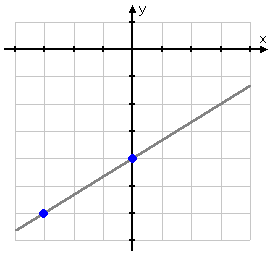
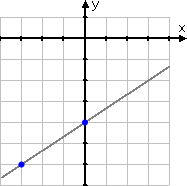
In stair-stepping to the right, going from the first indicate to the second signal, our "path" tin can be viewed equally forming a right triangle:
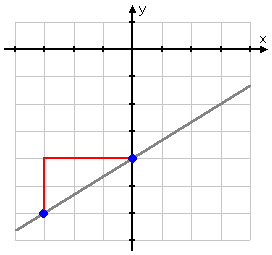
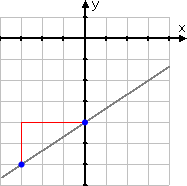
The vertical distance betwixt the y -values of the ii points (that is, the height of the triangle) is the " y 2 –y 1 " part of the slope formula. The horizontal distance between the x -values (that is, the side-to-side width of the triangle) is the " 10 2 –x 1 " part of the gradient formula. The line we need to graph is the hypotenuse of the right triangle.
Annotation that the slope for this equation and graph is , or "two over three". To go from the first point to the second, nosotros go "upwards 2 and over three". This human relationship between the slope of a line and pairs of points on that line is always true; for a line equation" y = mx +b ", the "upward and over" values tin can always be obtained from the value of thou .
Having found 2 points on the line, we can keep to use this "upwards 2, over three" to discover further points for the line (and we'll want to plot at least three points, to make sure everything is lining up correctly).
To get to the "next" point on this line, we don't have to do any computationes. Instead, we can go up another two (to y = –2), and over some other 3 to the correct (to x = 3), giving united states:
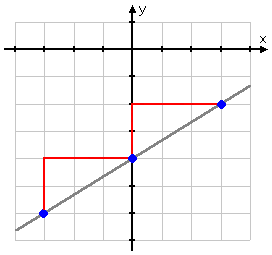
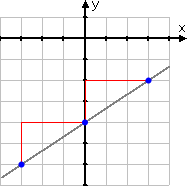
With these three points, nosotros take confirmed the graph of .
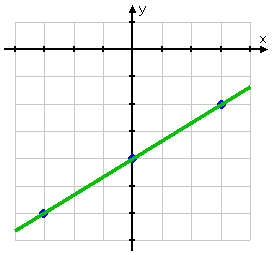
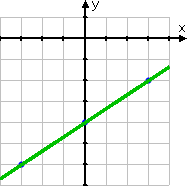
(If yous're not sure of validity of that last betoken, and so put 3 in for ten in the line equation, and verify that you practice indeed get –ii for y .)
By the way, did you discover that the line'southward equation had a "minus four", and the line crossed the y -axis at –4? This always happens; the y -intercept (that is, the place where the line crosses the y -centrality) for a directly line with equation " y = mx +b " is e'er going to exist at y =b .
In the previous instance, we started with a graphed line and its equation, plant a couple points on the line, found the slope and the y -intercept, and noticed the connection between the line's equation, the values of m and b , and how the equation graphed. Let's try another line equation, but this time nosotros won't start with the graph. Instead, we'll utilize the equation to detect the graph quickly and easily, with a minimum of plotting needed.
Our new equation is:
We've learned that the number multiplied onto the x is the gradient, so the gradient is m = –2 for this line. "But wait!", I hear you cry; "There is only an 'upwardly' (well, a 'downwards') for this slope; there isn't any 'over'!" Yes, you're correct... sort of. But nosotros tin can bargain with this past remembering that any number tin can exist put over "ane".
In this case, we tin use that fact to convert the slope value into a fraction. By putting the –ii over a 1, nosotros become a gradient value of . By using this trick, the gradient is now reformatted so as to tell usa clearly that, from any is our offset point, nosotros can get to the "side by side" indicate by going "down two, and over ane".
Let'southward start like shooting fish in a barrel with our input values, and employ ten = 0. Plugging this in, we become:
y = –2(0) + 3 = 0 + 3 = 3
So the point (0, iii) is on the line, and is the signal where the line crosses the y -axis. In fact, nosotros didn't fifty-fifty need to plug aught in for the variable, considering we can meet, right in the line'due south equation, that the y -intercept is going to exist at b = 3. So allow's plot that point:
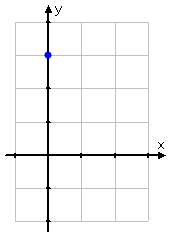
At present that we've got our offset point, we tin use the slope value to find more than points. Our restated slope value of tells us that, in going from one point to the (most user-friendly) next point, we will exist going "downwardly two and over one". (The "downward" comes from the "minus" sign on the slope's value. The "over" is always a move to the right, but the sign on the slope can have usa moving either up or down.) So, going down two and over i from the intercept to become to the next betoken, nosotros country at the point (i, 1):
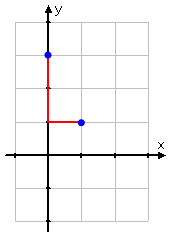
Going downwardly another two, and over another ane, we become to the next (convenient) betoken, (2, –one):
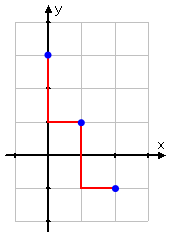
Then the betoken (two, –ane) is besides on this line. And with these three points, we tin can graph the line:
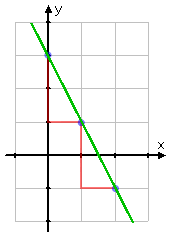
When you lot take the equation of a direct line, you can ever practise quick and easy graphing past starting with the y -intercept value, and then plotting other points by using the slope value. In "existent life", this may not work and then well. For case, I probably wouldn't try eye-balling the plot points for an equation like, say, y = 0.0062x – 379.04. Instead, I'd use software to get decimal approximations for the plot points. But, for most algebra-class exercises, the above method will work just fine, and tin be a real time-saver on tests.
Source: https://www.purplemath.com/modules/slopgrph.htm
Posted by: boothbyfirad1964.blogspot.com


0 Response to "How To Draw Graph If I Have Slope And Y Intercept"
Post a Comment